Question 1:
In which of the following places can you stop?
1. Only A.
2. Only B.
3. Only B and C.
4. In none.
You can stop only on the right, behind the pedestrian crossing at point B, p. 12.4. The requirement not to stop closer than 5 m in front of the pedestrian crossing will be violated not only in place A, but taking into account that the traffic is two-way, and in place B, although on this road stopping on the left is allowed in clause 12.1.
Question 2:
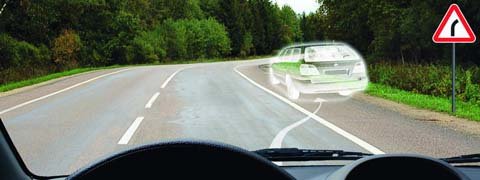
Are you allowed to park your car at the indicated place?
1. Yes.
2. No.
It is prohibited to park the car in conditions of limited visibility (sign "Dangerous turn") only on the carriageway, clause 12.4 and
p. 12.5. By parking your car on the side of the road, you will not break the Rules.
Question 3:
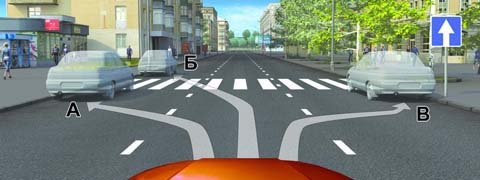
Are you allowed to stop at the indicated places?
1. Allowed only in B.
2. Allowed only in B.
3. Allowed only in A and B.
4. Prohibited.
You can stop at the indicated place (B), since the Rules do not prohibit stopping on the left side of a one-way road in settlements directly behind the pedestrian crossing. In front of him (places A and B), stopping is prohibited by clause 12.1 and clause 12.4.
Question 4:
![]()
Are you allowed to stop at the indicated place?
1. Permitted.
2. Permitted, but only if there are no pedestrians at the crossing.
3. Not allowed.
From the place of the intended stop to the edge of the crossed carriageway, it is exactly 5 m. Stopping in front of the intersection is prohibited if this distance is less than 5 m. However, stopping at the indicated place is still prohibited, since the distance between your car and the pedestrian crossing will be less than 5 m. Section 12.4.
Question 5:
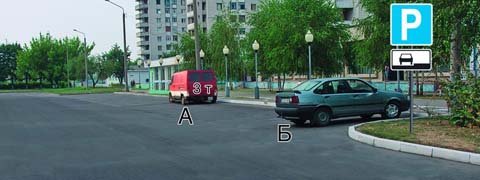
1. Only A.
2. Only B.
3. Nobody broke.
4. Both have violated.
In places where the carriageway is widened, cars can be parked, both at an angle and parallel to the edge of the carriageway, clause 12.2. However, if there is a sign “Parking place” with a sign “Method of parking a vehicle”, all cars (cars and trucks) must be parked only parallel to the edge of the carriageway. Consequently, the driver of the car B.
Question 6:
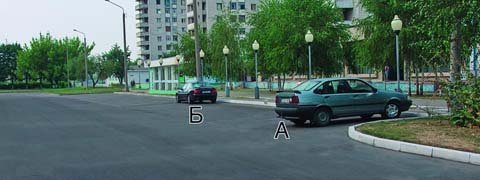
Which driver violated the parking rules?
1. Only A.
2. Only B.
3. Nobody broke.
In this situation, none of the drivers violated the Rules, since they parked the cars at the widening of the carriageway, where parking is allowed both at an angle to the edge of the carriageway and parallel to it, clause 12.2.
Question 7:
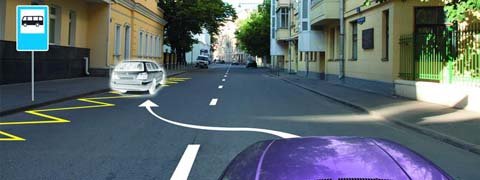
Are you allowed to stop at the specified place to drop off passengers?
1. Permitted.
2. Permitted if there is no interference with the movement of route vehicles.
3. Prohibited.
Since in settlements stopping on the left side of the road with one lane in each direction is allowed in clause 12.1, you can stop at the indicated place, but only for picking up or disembarking passengers and provided that this does not interfere with the movement of route vehicles clause 12.4 ...
Question 8:
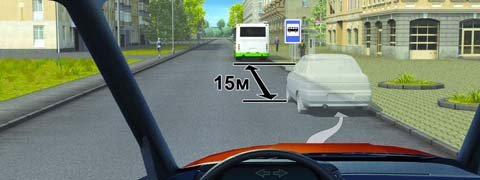
1. Permitted.
2. Permitted, if this does not interfere with the movement of route vehicles.
3. Prohibited.
At 15 m from the sign of the stop point of route vehicles, parking is permitted by the Rules without any restrictions in clauses 12.4 and 12.5.
Question 9:
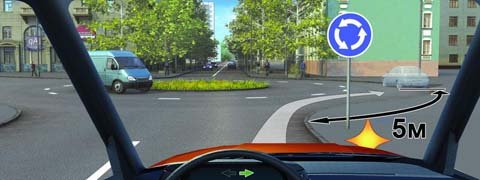
Can you stop at the indicated place after turning right?
1. Yes.
2. No.
You can stop at the indicated place, since the distance to the edge of the crossed carriageway is 5 m, p. 12.4.
Question 10:

In which of the indicated places you can park a car?
1. Only A.
2. Only V.
3. A or B.
4. In none.
On roads with one-way traffic in settlements, stopping and parking of cars is allowed both on the right and on the left side of the road at the edge of the carriageway, clause 12.1. However, if you park your car in position B, you violate the requirements of the No Parking sign.
Question 11:
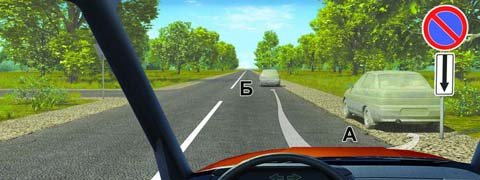
In which of the following places are you allowed to park your car?
1. Only A.
2. Only B.
3. Anything.
The "Coverage" sign indicates the place where the coverage area of \u200b\u200bthe "No parking" sign ends. You can park your car behind the sign, but only on the side of the road, i.e. in position A of item 12.1.
Question 12:

Are you allowed to park your car at the indicated place if there is a narrow shoulder?
1. Permitted.
2. Permitted, but only during daylight hours.
3. Prohibited.
Outside settlement if there is a sign "Main road" you are prohibited from parking your car using the carriageway, clause 12.5.
Question 13:

In which of the following places can you stay?
1. Only V.
2. Only A and B.
3. Only B and C.
4. Anything.
Outside settlements, stopping is allowed on the right side of the road, clause 12.1. If there is a curb, you should stop only on it, i.e. in place of V.
Question 14:
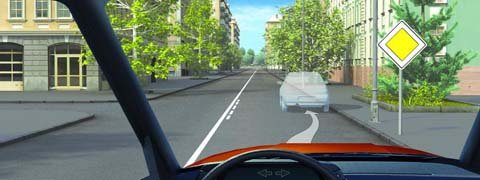
Are you allowed to stop at the specified place at the intersection?
1. Permitted.
2. Allowed if the distance from your vehicle to the marking line is at least 3 m.
3. Prohibited.
Opposite the side passage of the three-way intersection, you can stop only if there is a dividing strip or a solid marking line 1.1. In this situation, line 1.11 is drawn at the intersection, therefore, you are prohibited from stopping, even if the distance from the car to the marking line is more than 3 m. P. 12.4.
Question 15:

What signs do not apply to vehicles driven by disabled people of I and II groups, transporting such disabled people or disabled children?
1. Only A and B.
2. Only B and D.
3. Only B, C and D.
4. Everyone.
Vehicles driven by disabled people of I and II groups or transporting them and disabled children are not subject to the signs "No traffic" (B) and "Parking is prohibited" (D). p. 12.1 Correct answer - Only B and D.
Question 16:
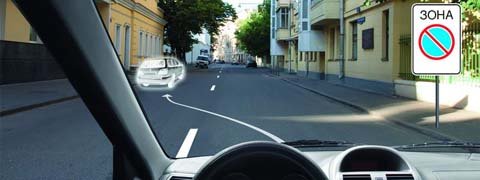
Are you allowed to park your car at the indicated place?
1. Forbidden.
2. Permitted.
The sign "Restricted parking zone" prohibits parking throughout the entire territory (section of the road), and not only on the specified side, and it is valid until the exit from zone 5.28 "End of the restricted parking zone" clause 12.1.
Question 17:
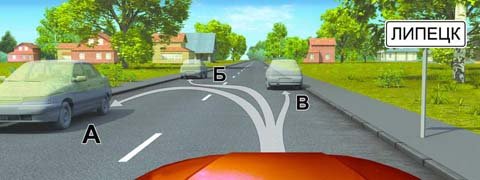
Where can you stop?
1. Only V.
2. Only B and C.
3. Anything.
You can stop at any place, as in settlements (sign "Beginning of a settlement") on roads with one lane for each direction without tram lines in the middle, stopping is allowed both on the right and on the left side of the road, clause 12.1.
Question 18:
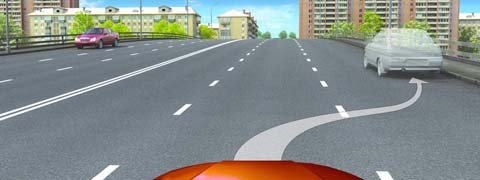
Can you stop at the specified place on the bridge?
1. Yes.
2. Yes, only for disembarking passengers.
3. No.
You can stop at the indicated place, since if there are three or more lanes of traffic in this direction, stopping at bridges, overpasses and overpasses is allowed in clause 12.4.
Question 19:
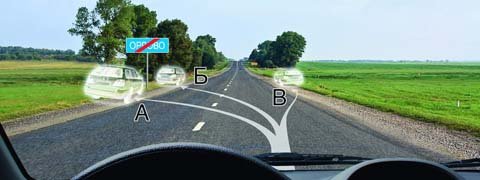
1. Only V.
2. B or C.
3. Anything.
In this situation, you are allowed to park the car only in position B, since clause 12.1 of the Rules allows you to park the car on the right side of the roadside. According to this paragraph of the Rules, you can park your car on the left side of the road only in the village. However, the sign "End of a populated area" (on a blue background) informs that on this road before the sign and after it, the provisions of the Rules for traffic in populated areas do not apply.
Question 20:
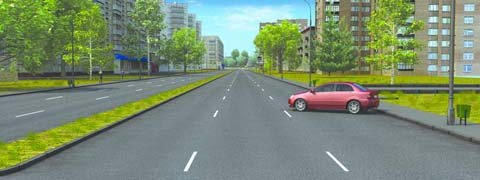
Has the driver of the car violated the Rules by parking the car in this way?
1. No.
2. No, if this does not interfere with the movement of other vehicles.
3. Yes.
It is allowed to park the car at an angle to the edge of the carriageway only where there is a local widening of the carriageway. In other places the driver is obliged to park the car parallel to the edge of the carriageway, clause 12.2.
Question 21:

Which vehicles can be parked in the manner indicated on the plate?
1. Passenger cars and motorcycles only.
2. All except for trucks with an MPW exceeding 3.5 tonnes.
3. Any means of transport.
The sign "Parking place" with the sign "Method of parking the vehicle", as well as clause 12.2 of the Rules prohibit the use of the sidewalk edge for parking by any trucks... Only passenger cars and motorcycles can be parked in the manner indicated on the plate.
Question 22:
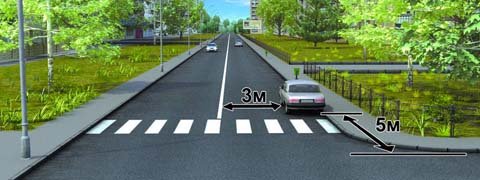
Is the driver allowed to park the car at the designated location?
1. Yes.
2. No.
Stopping behind a pedestrian crossing 5 m from the edge of the intersected carriageway and ensuring a distance of 3 m to the solid line of the marking, the driver did not violate the parking rules clause 12.4 and clause 12.5.
Question 23:
Where is it allowed to park for a long rest or overnight on the roads outside the village?
1. Only in a clearly visible place on the side of the road.
2. Anywhere on the roadside.
3. Only on designated sites or off-road.
4. At any of the listed locations.
Parking for the purpose of long-term rest, overnight stay outside the settlement is allowed only on designated sites or outside the road, clause 12.3.
Question 24:
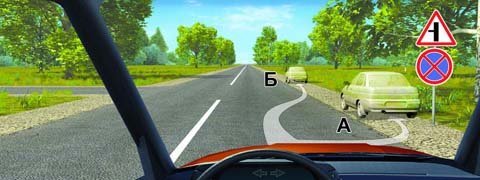
In which of the following places can you park your car?
1. Only A.
2. Only B.
3. None.
In this case, the zone of action of the sign "No stop is prohibited" extends to the nearest intersection. Hence, you can park your car on the side of the road behind the intersection. The correct answer is only B p. 12.1.
Question 25:

Is the driver allowed to park a truck with an MPW of less than 3.5 tonnes in the manner indicated on the plate?
1. Yes.
2. No.
The sign "Parking place" with a sign "Method of parking a vehicle", as well as clause 12.2 of the Rules prohibit the use of the sidewalk edge bordering the carriageway for parking for any trucks.
Question 26:
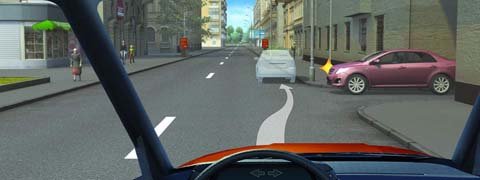
Can you park your car at the indicated place?
1. Yes.
2. No.
Stopping, and even more so parking in the indicated place, is prohibited, since it will be impossible for the vehicle to leave the yard, clause 12.4.
Question 27:

Can you stop at the passenger boarding bridge?
1. Yes.
2. No.
You cannot put a passenger in this place, since on bridges, overpasses and overpasses, stopping is allowed only if there are at least three lanes for movement in this direction, clause 12.4.
Question 28:
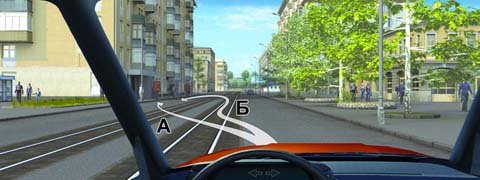
What trajectory can you take to approach the passengers?
1. Only according to A.
2. Only according to B.
3. Anyone.
You can approach passengers only along trajectory B, since if there are tram lines in the middle of the road, stopping on the left side with an approach along trajectory A is prohibited in clause 12.1.
Question 29:
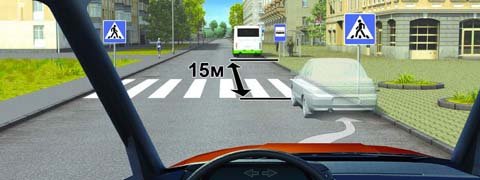
Are you allowed to park your car at the indicated place?
1. Permitted.
2. Permitted, if this will not interfere with the movement of route vehicles.
3. Prohibited.
Although you have complied with the requirement to park the car no closer than 15 m from the signpost of the stop of route vehicles, you still violate the Rules, since stopping and parking are prohibited at pedestrian crossings and clauses 12.4 and 12.5 in front of them.
Question 30:

Are you allowed to stop in a car at the indicated place?
1. Yes.
2. No.
Since the distance between the car and the solid line of the marking (taking into account the dimensions of the car) is less than 3 m, you cannot stop at this point, clause 12.4
Question 31:

Has the driver of a truck with a maximum MPW of not more than 3.5 tonnes violated the parking rules in this situation?
1. Yes.
2. No.
The driver violated the parking rule, since such parking is prohibited for trucks, regardless of the permitted maximum weight, in clause 12.2, and cars and motorcycles are allowed if there is a parking space sign with one of the “Method of parking vehicle parking” signs.
Question 32:
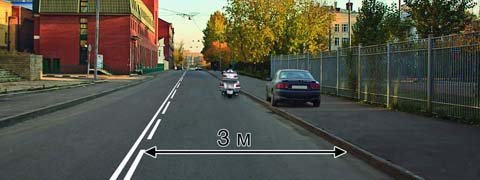
Which driver violated the parking rules?
1. Both have violated.
2. Only the driver of the car.
3. Only the motorcycle rider.
4. Nobody broke.
In this situation, only the driver of a car violated the parking rules, as he used the sidewalk p. 12.2 for parking. Parking at a distance of less than 3 m to the broken line of the marking is not prohibited.
Question 33:

1. Only the driver of a car.
3. Both have violated.
Both drivers violated the stopping rules, as on motorways stopping is allowed only at special parking areas, marked with signs "Parking place" or "Resting place" p. 16.1. In addition, the driver of the car stopped to the left of the edge line, i.e. on the carriageway, item 12.1.
Question 34:
![]()
Which car driver violated the stopping rules?
1. Only B.
2. Only B and C.
3. All have violated.
If there is a roadside, stopping and parking the vehicle is allowed only on it, clause 12.1. Cars B and C, despite the sufficient shoulder width, are wholly or partially on the carriageway, interfering with the movement of other vehicles.
Question 35:
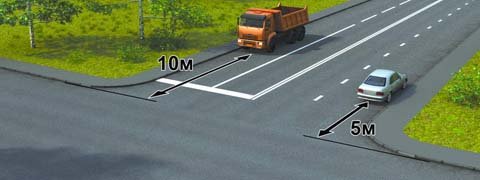
Who broke the stopping rules?
1. Both drivers.
2. Only the truck driver.
3. Only the driver of a car.
4. Nobody broke.
Stopping is prohibited closer than 5 m from the edge of the crossed carriageway, and the drivers complied with this requirement. However, the truck driver nevertheless violated the Rules, since the distance between the vehicle and the solid marking line is less than 3 m, clause 12.4.
Question 36:
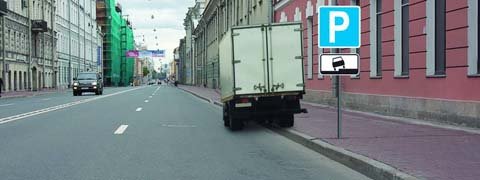
Is the driver allowed to park the truck at this location in the specified manner?
1. Yes.
2. Yes, if the permissible maximum vehicle weight is less than 3.5 tons.
3. No.
A sign "Parking place" with a sign "Method of parking a vehicle" and clause 12.2 of the Rules prohibit any trucks from using the edge of the sidewalk for parking.
Question 37:
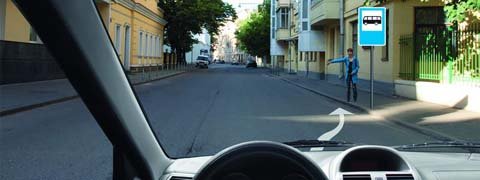
Are you allowed to stop for passenger boarding at this point?
1. Permitted.
2. Permitted, if this will not create obstacles to the movement of route vehicles.
3. Prohibited.
The rules allow stopping closer than 15m from the stop indicator of route vehicles only for embarking or disembarking passengers, provided that there is no interference with the movement of route vehicles, clause 12.4 of the SDA.
Question 38:
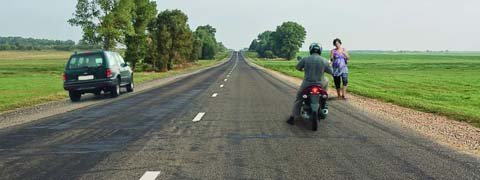
Which driver violated the stopping rules?
1. Only the driver of the car.
2. Only the motorcycle rider.
3. Both have violated.
4. Both did not break.
Both drivers violated the Rules as the motorcyclist had to pull over to the side of the road. Stopping on the left outside settlements is prohibited by clause 12.1.
Question 39:
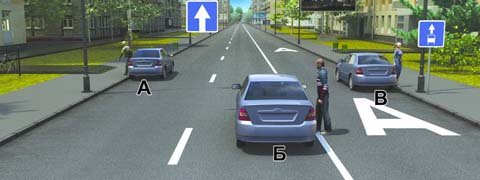
Which driver stopped correctly to disembark passengers?
1. Only A.
2. Only V.
3.A and B.
4. B and C.
Only driver A stopped correctly to disembark passengers, since stopping on the left on one-way streets is allowed in clause 12.1. The driver of car B violated the requirements of the Rules by placing him at a solid lane, not at the sidewalk. The driver of car B stopped on the lane intended for the movement of route vehicles only, where movement and stopping of other vehicles is prohibited by clause 18.2.
Question 40:
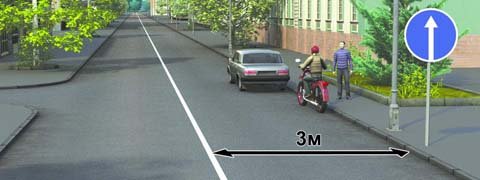
Are drivers allowed to stop at the designated locations?
1. Permitted.
2. Allowed only for motorcyclists.
3. Prohibited.
In this case, stopping is prohibited for both drivers, since the distance between the vehicle and the solid marking line is less than 3 meters, clause 12.4.
Question 41:
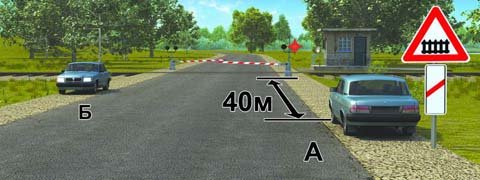
Which driver violated the parking rules?
3. Both have violated.
4. Both did not break.
Both drivers violated the Rules, as parking is prohibited closer than 50 m on both sides of the railway crossings, clause 12.5.
Question 42:
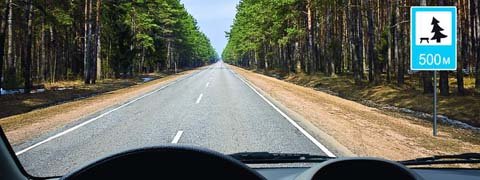
Where on this section of the road can you park your car for a long time?
1. Anywhere on the roadside.
2. Only after 500 m on a special site.
3. In both places indicated.
Parking for the purpose of a long rest, overnight stay outside the settlement is allowed only on designated sites or outside the road, clause 12.3. The sign "Resting place" informs that such a site is located at a distance of 500 m. Therefore, you can park your car for a long time only after 500 m.
Question 43:
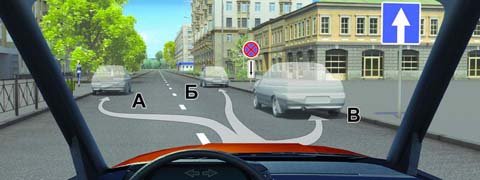
In which of the following places can you stay with a car?
1. Only B.
2. Only A and B.
3. Only A and B.
4. Anything.
In settlements on one-way roads, cars are allowed to stop on the left side of the road, clause 12.1. The sign "Stop prohibited" with the sign "Zone of action" shows that behind the sign the stop prohibited zone ends (car B). In addition, the sign is valid only on the side of the road on which it is installed - therefore, it does not apply to car A. Hence, you can stop at locations A and B.
Question 44:
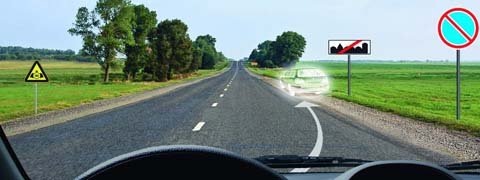
Are you allowed to park at the indicated place?
1. Permitted.
2. Allowed, but only during daylight hours.
3. Prohibited.
The zone of action of the sign "No parking" in this situation extends to the end of the settlement (Appendix 1). Having parked your car on the side of the road behind the sign “End of the settlement”, you did not violate the requirements of the sign and clause 12.1 of the Rules.
Question 45:
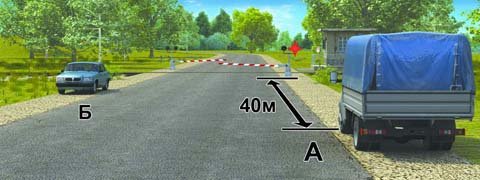
Which driver violated the stopping rules?
1. Only the driver of car A.
2. Only the driver of car B.
3. Both did not break.
4. Both have violated.
None of the drivers violated the Rules, since stopping is prohibited only directly at the railway crossing, clause 12.4.
Question 46:
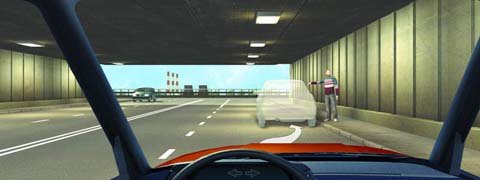
Can you stop to pick up a passenger?
1. Yes.
2. No.
You cannot stop at this place, since the Rules prohibit stopping in tunnels, under overpasses, bridges and overpasses, clause 12.4.
Road sign « Bus stop»Is well known not only to drivers, but also to all pedestrians; even a child of kindergarten age is able to distinguish the marker. However, despite the fact that everyone from childhood knew and saw the pointer, having received, the newly-made driver is able to make a little mistake, performing actions for which a certain punishment is provided in the traffic rules. The "Bus stop" sign denotes a section of the road surface that is set aside for a city bus or public minibus stop. Do not neglect the road signs, every driver must clearly know how to act when this sign appears ahead.
The Bus Stop sign is well known
Pointer location
In accordance with paragraph of the rules, sign 5.16, which serves to indicate the place of stopping of a city bus, is installed on sections of the road where stops of public vehicles are located. The installation of the appropriate sign must be carried out at the middle or end point of the stopping zone. However, sometimes the stop for shuttle buses or trolley buses has a significant length that exceeds the standard dimensions, then the sign must be repeated.
Extreme care and great responsibility
It's no secret that many careless drivers neglect not only the speed limit, but also compliance. For example, a sign indicating the place of a city bus or trolleybus stop should increase the discipline of all road users.
Based on the traffic rules of Russia, all signs that indicate the presence of a bus stop must be bilateral. Naturally, such an important condition is provided so that all cars (passing and oncoming) that are currently present on the road can still see the corresponding sign from a distance and be informed about the nearby stop of public passenger transport. All this is aimed at ensuring that drivers can take the necessary safety measures in time. In particular, when approaching a stop, slow down, wait for overtaking, increase alertness for the possible presence of pedestrians crossing the road, and maneuver exclusively in accordance with traffic rules.
According to the new rules, the "Bus Stop" road sign can be used in one bundle with a certain road surface marking, that is, there must be a yellow broken line drawn in a strictly horizontal direction on the road. Such a specialized section also indicates a stop for public buses and trolleybuses.
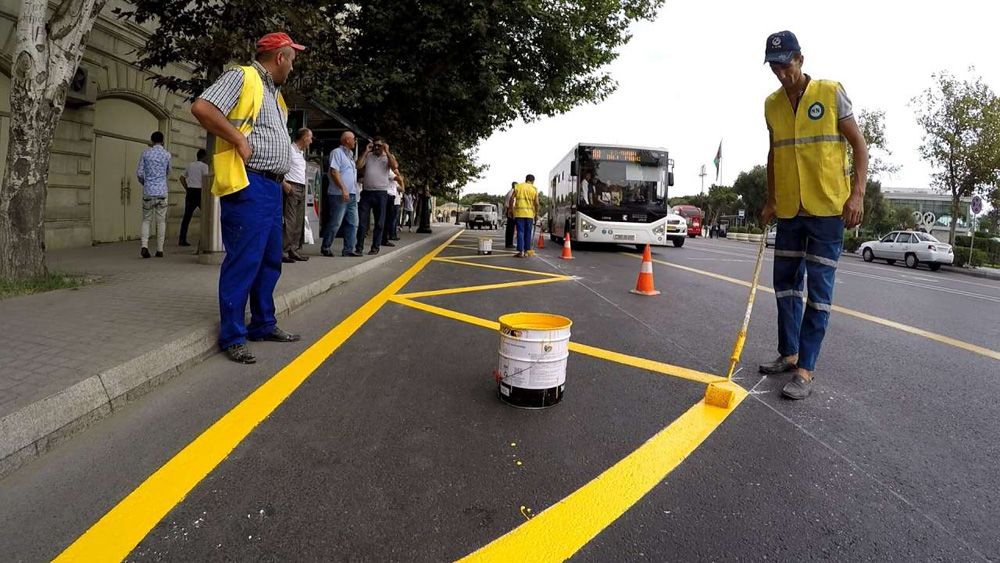 Often the sign "Bus stop" duplicates the markings
Often the sign "Bus stop" duplicates the markings You should not neglect the rules on the road, even if there is a possibility that an unpredictable car owner will not be noticed and there is no need to create emergency or simply uncomfortable situations for other road users. The sign indicating a bus stop is considered in detail in the 8th and 12th sections of the traffic rules of the Russian Federation. Where it is said that in places where public vehicles stop, it is strictly forbidden to perform some unsafe maneuvers. First of all, you cannot move backwards and make U-turns, secondly, park or even stop a car at a distance of less than 15 m. Moreover, the last condition provides for a ban on stopping not only before, but also after the sign. However, this paragraph has one caveat: a vehicle that does not interfere with the movement of a route vehicle can make a short stop to disembark / pick up passengers in the area of \u200b\u200bthe sign indicating the bus stop.
Rules and rules again
In order not to get into a situation when you have to argue with the traffic police about the legitimacy of your actions, you should thoroughly study the innovations in the traffic rules, it is they who will help resolve conflicts and troubles on the road. So, the presence of a sign indicating the location of a bus stop indicates that the driver of any vehicle can, if necessary, make a stop at a public transport stop. However, you should think about whether this is contrary to the basic rules? And what do you mean by a permitted stop? A motorist can make a stop, in other words, forced braking only when he needs to disembark or disembark a person from / to his car. In addition, it is even allowed to unload and on the condition that the vehicle is stopped in this place for no more than 5 minutes.
It turns out that a person who stopped directly at a bus stop is not always an offender in relation to other road users, in addition, he commits completely legitimate actions if the duration of his stop does not exceed 5 minutes. Naturally, in addition to personal needs and needs, social needs should also be taken into account, do not forget that the temporary parking place is a shuttle bus stop, so you should not stop here for no apparent reason, creating additional obstacles or difficulties for the movement of minibuses and buses.
An exception to the traffic rules can be only emergency cases when the stop was provoked by a car breakdown or an accident that has affected the area of \u200b\u200bthe bus stop. If, nevertheless, this happened, it is necessary to eliminate the breakdown as quickly as possible, or, having recorded the accident, try to make room for the normal functioning of shuttle buses.
Possible situations: how to act correctly?
Even the most careful and prudent people can sometimes find themselves in very awkward and unpredictable situations, which can sometimes be serious. Quite often it happens that on a well-surveyed section of the route where the bus stop sign provided for in paragraph 5.16 is valid, the driver makes an illegal stop, turns around or moves in reverse, or, even worse, thinking or being distracted by extraneous matters the route he needs without giving way to the bus.
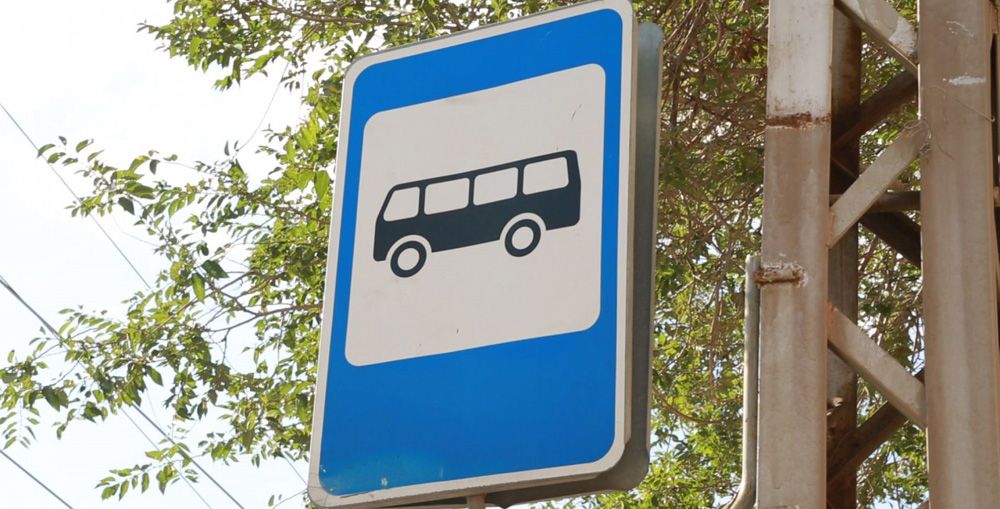
If such an action is noticed by an employee of the road-guard service, most likely, the negligent driver will be "awarded" with a fine. However, there are situations when unexpected cash spending can be avoided. The driver who violated the rules can avoid a fine if the corresponding sign is actually absent or there is no necessary markings on the road surface.
A person should point out to a law enforcement officer that, even though there is a real stop for minibuses, an important formality has not been observed on a specific section of the road, that is, there are no established signs and corresponding markings. Only in this case it is possible to try to prove legal innocence, as a result of which the driver did not violate the rules and, accordingly, administrative penalties in the form of a fine or other penalty cannot be applied to him.
Proving innocence by talking to a traffic police officer
The road sign indicating the place of the bus stop may be missing for several reasons: either it is a new stop, where they simply did not have time to install the corresponding sign, or the previously installed sign was damaged and removed, and a new one has not yet been installed in its place. However, whatever reason preceded the absence of a certain pointer, a car owner who has violated the rules can tactfully and unobtrusively enter into polemics with a traffic police officer. Most likely, a person who is confident in his righteousness will succeed in convincing the employee during execution not to write out a fine. In this case, it will not be superfluous to have an additional photo or one that, if necessary, will help to prove the legality of your actions, where the bus stop was not equipped with the necessary signs or indicators. If there is no road sign "Bus stop" or yellow markings, a person will be able to prove his case even if the case comes to trial.

However, it is possible to avoid administrative punishment even in a situation where a certain sign is present, however, in this case, it must be hidden from free view. Such situations are not uncommon in large metropolitan areas, when huge advertising posters and billboards, pillars and branches of trees can obstruct a normal view, blocking the signs. In such situations, it will not be easy to get out right, since it will be rather difficult to prove innocence. The main thing is to provide strong arguments (photo or video) that indicate the fact that the signs are not visible.
Penalties for breaking the rules
If the car owner, for any reason, had to stop directly at the bus stop itself, the traffic police officer who noticed this offense is authorized to issue a fine, the amount of which will be about 1000 rubles. In such central regions as Moscow or St. Petersburg, the amount of monetary compensation is three times higher: the driver will have to pay 3000 rubles.
The road sign "Bus stopping place" should warn motorists about the ban on stopping at a certain interval of the roadway. Without special need, you cannot stop your vehicle not only at the bus "parking", but also within 15 meters that precede and end it. This distance, equal to 15 meters, should be read directly from the sign indicating the presence of a shuttle bus stop. In the event that such a sign is not visible or not at all, the distance must be "measured" from the pocket and the markings.
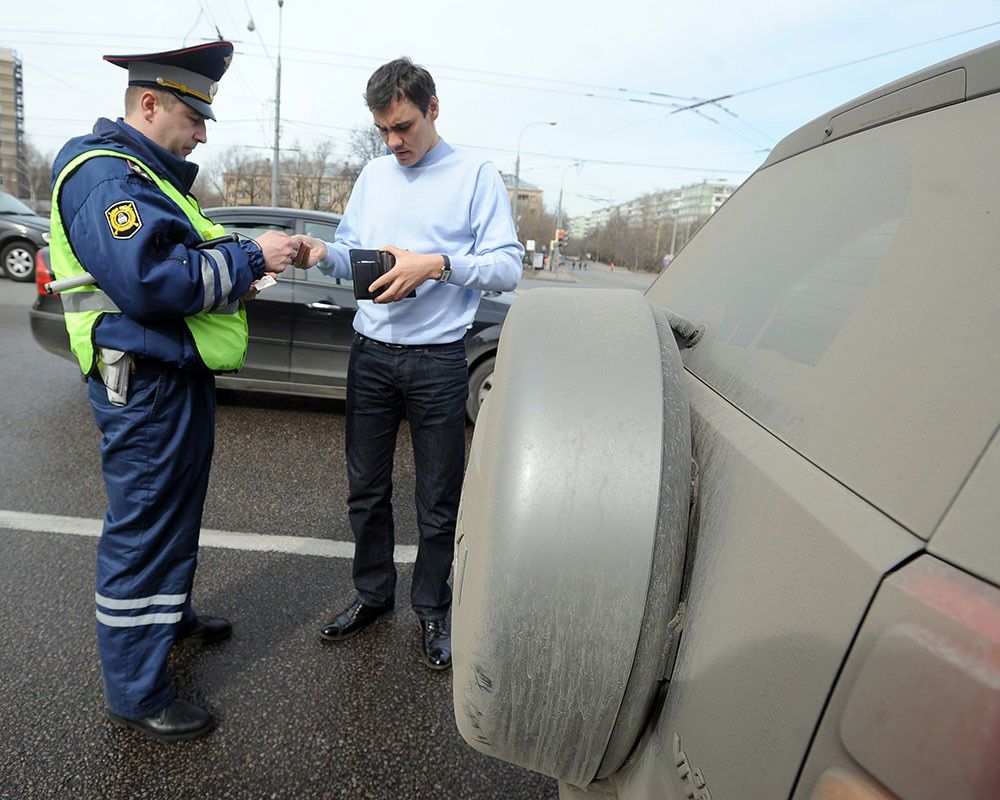
In addition to the monetary penalty, another trouble may lie on the driver who neglected the traffic rules - the car can be evacuated to a specialized parking lot. As a result, a person, in addition to a fine, will be forced to pay additional costs associated with the transportation and storage of his car in the parking lot. In such a situation, naturally, it will be better for the driver of the vehicle if he is nearby and can independently remove the obstacle created by his car. In this case, the car will not be evacuated, the owner will be able to rearrange it on his own and drive it away from the wrong place.
Conclusion
Traffic rules must be known and followed primarily not in order to avoid unforeseen monetary penalties, but in order not to interfere with other road users. It should be remembered that the road is a place where mutual politeness and respect will not be superfluous. Neglecting traffic rules, a person simply neglects not only his own life, but also the health of other people. Recently, in Russia, there have been more cases when drunk drivers have run over a public transport stop, as a result of which innocent people have been injured. You do not need to risk what is given only once, you should take care of yourself and your loved ones.
The best prices and conditions for the purchase of new cars
Credit 4.5% / Installment / Trade-in / 95% of approvals / Gifts in the salonMas Motors
Ticket 16 - Question 1
Are vehicle drivers allowed to sit in an organized convoy?
1. Permitted.
2. Permitted if the road has no more than three lanes for traffic.
3. Permitted if the speed of vehicles moving in the convoy is not more than 30 km / h.
The driver of any vehicle is prohibited from both crossing organized columns and taking a seat in them (clause 2.7).
Correct answer:
It is prohibited.
Ticket 16 - Question 2
Which courtyard can you enter in this situation?
1. Turns into courtyards are prohibited.
2. Only to the courtyard to the right.
3. Only to the left in the yard.
4. In any.
Question:
The arrows are not visible on the unlit sections of the traffic light, I cannot know what will be displayed there, thus I cannot say where I will move.
Answer:
The other sections of the traffic light will show the same arrow to the right. The same arrows are always drawn on all sections.
Correct answer:
When the green signal turns on, continue driving only to the right.
Ticket 16 - Question 7
Emergency signaling on towed mechanical vehicle must be enabled:
1. Only in poor visibility conditions.
2. Only in the dark.
3. In all cases when towing is carried out.
In all cases, when towing is carried out, the emergency signaling must be switched on on the towed mechanical vehicle (clause 7.1).
Correct answer:
In all cases when towing is carried out.
Ticket 16 - Question 8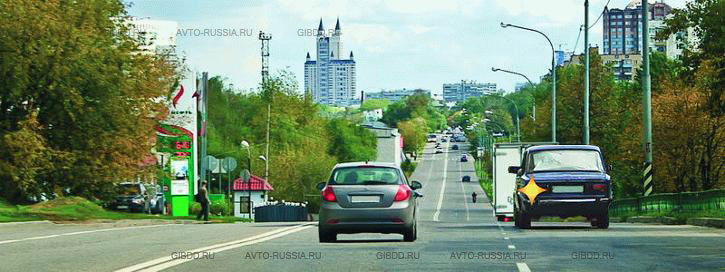
Is the driver of a car driving in the left lane obliged to give way in this situation?
1. Obliged.
2. Not required.
The driver of a car driving in the left lane without changing the direction of travel is not obliged to give way to a car whose driver intends to change to the left lane (clause 8.4).
Correct answer:
Is not obliged to.
Ticket 16 - Question 9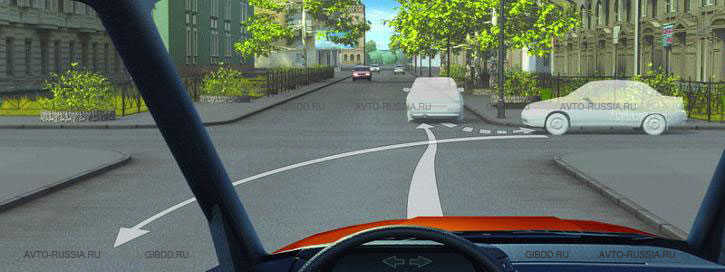
Can you make a U-turn at an intersection while reversing?
2. It is possible, if at the same time there will be no interference with other road users.
3. It is impossible.
It is impossible to turn around in this way, since reverse movement is prohibited at crossroads (clause 8.12).
Correct answer:
You can't.
Ticket 16 - Question 10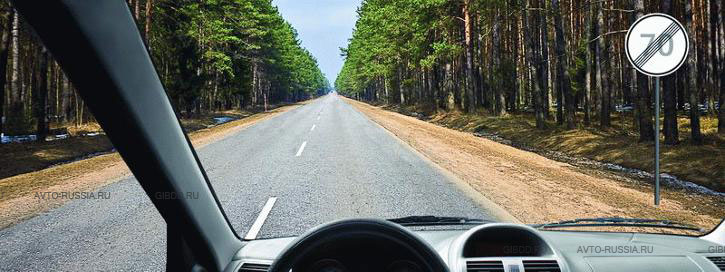
With what maximum speed can you continue driving while driving a car?
Correct answer:
90 km / h.
Ticket 16 - Question 11![]()
Are you allowed to overtake in this situation?
1. Permitted.
2. Permitted only if the tractor speed is less than 30 km / h.
At unregulated intersections, overtaking is prohibited when driving on a road that is not the main one (clause 11.4). As you are approaching an intersection of unequal roads, moving along a main road (sign 2.1 "Main road"), you can overtake at this intersection.
Correct answer:
Allowed.
Ticket 16 - Question 12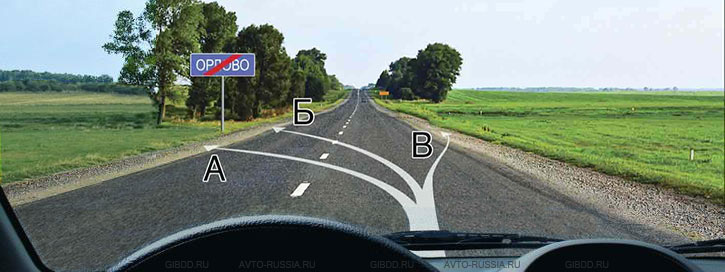
In which of the following places can you park your car?
1. Only V.
2. B or C.
3. Anything.
In this situation, you are allowed to park your car only in place B, since clause 12.1 of the Rules allows you to park your car on the right side of the roadside. According to this clause of the Rules, under certain conditions it is allowed to park a car on the left side of the road only in a populated area. However the sign 5.26  "End of the built-up area" (on a blue background) informs that on this road, both before the sign and after it, the provisions of the Rules for traffic in built-up areas do not apply.
"End of the built-up area" (on a blue background) informs that on this road, both before the sign and after it, the provisions of the Rules for traffic in built-up areas do not apply.
Correct answer:
Only in.
Ticket 16 - Question 13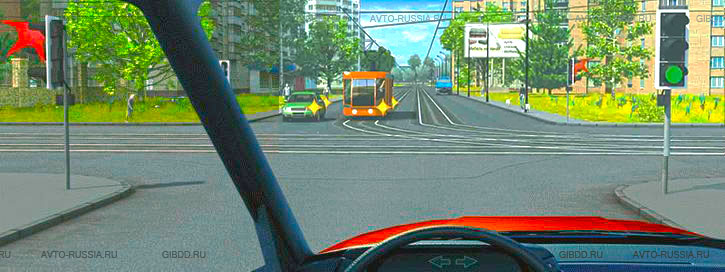
You intend to drive straight ahead at the intersection. Who should you give way to?
1. Tram and car.
2. Only a tram.
3. Nobody.
The green traffic light gives the right to move for you and the oncoming vehicle (clause 6.2). In this case, you must give way only to a tram, since it has an advantage over trackless vehicles (clause 13.6). An oncoming passenger car must give you the road, as it turns left (p. 13.4).
Correct answer:
Only a tram.
Ticket 16 - Question 14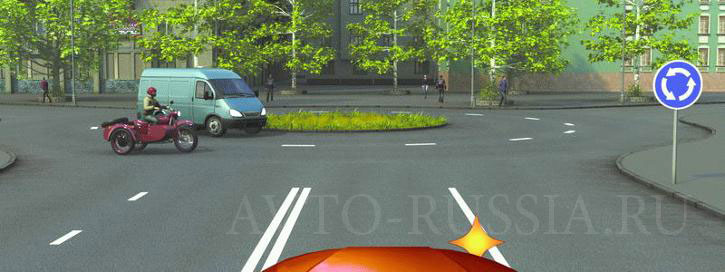
When entering an intersection, you:
1. Take precedence over both vehicles.
2. Must give way only to a car.
3. Must give way to both vehicles.
At the entrance to an intersection where a roundabout is organized, indicated by sign 4.3 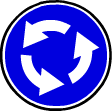 "Roundabout", you are obliged to give way to all vehicles moving along such an intersection (clause 13.11 1).
"Roundabout", you are obliged to give way to all vehicles moving along such an intersection (clause 13.11 1).
Question:
Since November 8, 2017, the rules for driving roundabouts have been changed.
Answer:
The circle, by definition, is the main road p. 13.11 1 of the SDA.
Correct answer:
Must give way to both vehicles.
Ticket 16 - Question 15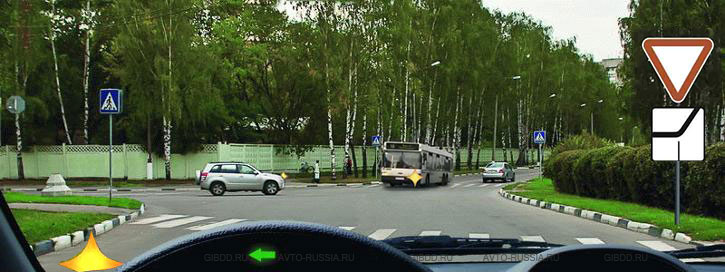
Whom do you have to give way to when turning left?
1. Bus only.
2. Only for a passenger car.
3. Both vehicles.
As you approach the junction of unequal roads on a secondary road (signs 2.4 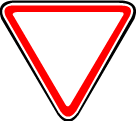 Give way and 8.13
Give way and 8.13  "Direction of the main road"), you must give way to both vehicles that are on the main road, regardless of the direction of their further movement (section 13.9).
"Direction of the main road"), you must give way to both vehicles that are on the main road, regardless of the direction of their further movement (section 13.9).
Correct answer:
Both vehicles.
Ticket 16 - Question 16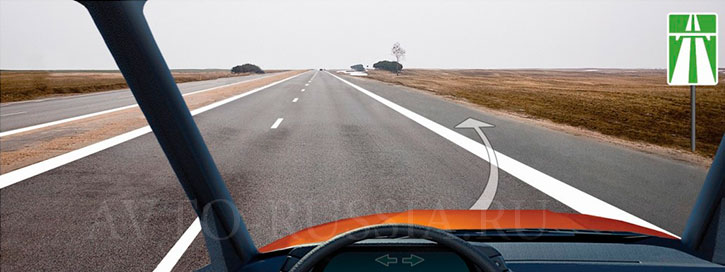
Are you allowed to stop on the motorway to the right of the line marking the edge of the carriageway?
1. Permitted.
2. Permitted only in case of a forced stop.
You can stop on the motorway to the right of line 1.2.1, which marks the edge of the carriageway, only in case of a forced stop, i.e. stopping the movement of the vehicle due to its technical malfunction or danger created by the transported cargo, the condition of the driver or passenger (clauses 16.2 and 1.2).
Correct answer:
Permitted only in case of a forced stop.
Ticket 16 - Question 17
Are they similar, but the answers are completely different?
Answer:
In this question (ticket 16 question 18), a maximum slope of 23% is determined, at which the parking brake system must ensure a stationary state of the car. If the slope is more than 23%, then the vehicle is allowed to move. Therefore, the correct answer is up to 23% inclusive. In ticket 12, question 18 is about 16%, but the comparison is based on other parameters (control lamp, pedal travel). Since 16 is less than 23, then the operation of the vehicle at 16% is even more prohibited.
Correct answer:
Up to 23% inclusive.
Ticket 16 - Question 19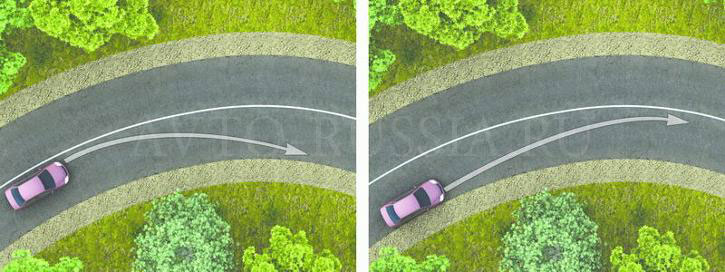
When turning to the right, traffic safety is achieved by making a turn along the path shown:
2. Three fingers of the hand are placed on the right or left side of the neck at the level of the thyroid cartilage of the larynx (Adam's apple) and gently advance deep into the neck between the thyroid cartilage and the muscle closest to the cartilage.
3. The thumb is placed on the neck under the chin on one side of the larynx, and the rest of the fingers on the other side.
The pulse on the carotid arteries is determined even at low pressure, which is very important for establishing the signs of life of the victim. The carotid arteries are located along the neck on the left and right sides of the thyroid cartilage of the larynx (Adam's apple). To determine the pulse, three fingers of the hand are placed on the right or left side of the neck at the level of the Adam's apple and gently advanced deep into the neck between the thyroid cartilage and the muscle closest to the cartilage.
Correct answer:
Three fingers of the hand are placed on the right or left side of the neck at the level of the thyroid cartilage of the larynx (Adam's apple) and gently advance deep into the neck between the thyroid cartilage and the muscle closest to the cartilage.

